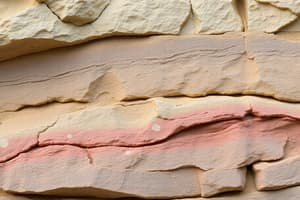Podcast
Questions and Answers
What is the primary factor that enables the preservation of an organism as a fossil?
What is the primary factor that enables the preservation of an organism as a fossil?
- Large size of the organism
- Rapid burial of the organism (correct)
- Long exposure to air
- Presence of water during decomposition
Which type of fossil provides evidence of the movement and behavior of ancient organisms?
Which type of fossil provides evidence of the movement and behavior of ancient organisms?
- Impressions
- Trace fossils (correct)
- Body fossils
- Mold fossils
Which organisms are more likely to be preserved as fossils?
Which organisms are more likely to be preserved as fossils?
- Organisms with external shells or bones (correct)
- Organisms with soft bodies
- Organisms that lived in high temperatures
- Only aquatic organisms
How do fossils contribute to our understanding of Earth's history?
How do fossils contribute to our understanding of Earth's history?
In what type of material can an impression of an organism be preserved?
In what type of material can an impression of an organism be preserved?
What is a key process in the formation of sedimentary rocks?
What is a key process in the formation of sedimentary rocks?
Which environment is likely to lead to the formation of limestone?
Which environment is likely to lead to the formation of limestone?
Which of the following fossilization processes involves filling spaces within an organism's remains with minerals?
Which of the following fossilization processes involves filling spaces within an organism's remains with minerals?
What are fossil fuels primarily composed of?
What are fossil fuels primarily composed of?
Which type of sedimentary rock would likely form from fine-grained mud?
Which type of sedimentary rock would likely form from fine-grained mud?
How is coal formed?
How is coal formed?
Where are oil and natural gas typically found?
Where are oil and natural gas typically found?
Which process involves the dissolution and mineral replacement of an organism's hard parts?
Which process involves the dissolution and mineral replacement of an organism's hard parts?
Flashcards
Impression Fossils
Impression Fossils
The shape of an organism preserved in surrounding rock, like shale or mud.
Trace Fossils
Trace Fossils
Evidence of ancient life, such as footprints, burrows, or fossilized poop (coprolites), that show how organisms moved or lived.
Fossil Formation: Rapid Burial
Fossil Formation: Rapid Burial
Rapid burial helps preserve organisms before they fully decay.
Fossil Formation: Hard Parts
Fossil Formation: Hard Parts
Signup and view all the flashcards
Importance of Fossils
Importance of Fossils
Signup and view all the flashcards
How are sedimentary rocks formed?
How are sedimentary rocks formed?
Signup and view all the flashcards
What is compaction?
What is compaction?
Signup and view all the flashcards
What is cementation?
What is cementation?
Signup and view all the flashcards
What are fossil fuels?
What are fossil fuels?
Signup and view all the flashcards
How is coal formed?
How is coal formed?
Signup and view all the flashcards
How are oil and natural gas formed?
How are oil and natural gas formed?
Signup and view all the flashcards
What are fossils?
What are fossils?
Signup and view all the flashcards
What is permineralization?
What is permineralization?
Signup and view all the flashcards
Study Notes
Formation of Sedimentary Rock
- Sedimentary rocks form from the accumulation and cementation of sediments.
- Sediments are particles of weathered rock, minerals, or organic matter.
- These sediments are transported and deposited in various environments, such as rivers, lakes, oceans, or deserts.
- Compaction and cementation are key processes in the formation of these rocks.
- Compaction occurs when the weight of overlying sediments presses down on the layers below, squeezing out water and compacting the particles together.
- Cementation involves the precipitation of minerals from water that fills the spaces between the sediment particles. These minerals act as a binding agent, cementing the sediments together.
- Different environments lead to varying types of sedimentary rocks.
- Examples include sandstone (formed from sand), shale (formed from fine-grained mud), and limestone (formed from the accumulation of calcium carbonate, often from marine organisms).
Fossil Fuels
- Fossil fuels are natural fuels formed from the remains of ancient organisms.
- They include coal, oil, and natural gas.
- Coal forms from the accumulation and compression of plant material in swamps or bogs over very long periods.
- Oil and natural gas originate from the remains of marine organisms (plankton and algae) buried under layers of sediment in the oceans.
- The high pressure and temperature deep underground transform the organic matter into hydrocarbons over millions of years.
- During this transformation process, layers of different types of organic sediments are deposited, contributing to the formation of various hydrocarbons that become coal, oil, and natural gas.
- Oil and natural gas are typically found trapped in porous rocks (reservoirs) beneath impermeable layers of rock (caps).
- The extraction of fossil fuels involves drilling operations and production techniques targeted towards reservoir extraction.
Fossils
- Fossils are the preserved remains or traces of ancient organisms.
- They provide evidence of past life forms and the history of life on Earth.
- Fossils can be formed through several different processes.
- Permineralization: Minerals dissolved in water fill the spaces within the organism's remains.
- Replacement: The original hard parts of the organism are dissolved and replaced by minerals.
- Carbonization: The organic matter of the organism is removed, leaving behind a thin film of carbon.
- Impressions: The shape of the organism is preserved as an impression in a surrounding material, such as shale or mud.
- Trace fossils: These are evidence of ancient life, such as footprints, burrows, or coprolites (fossilized feces), which show how the organism moved, lived, or interacted with their environment.
- Critical conditions for fossil formation include rapid burial to prevent decay, allowing for preservation.
- The types of organisms that fossilize are also influenced by the environment. Hard parts of organisms (bones, shells) are more likely to fossilize than soft parts.
- Fossils are important for understanding both the history of life and the Earth's environmental changes.
- Fossils can be used to correlate rock layers across different geographical locations to help build a timeline of the Earth's past.
Studying That Suits You
Use AI to generate personalized quizzes and flashcards to suit your learning preferences.




